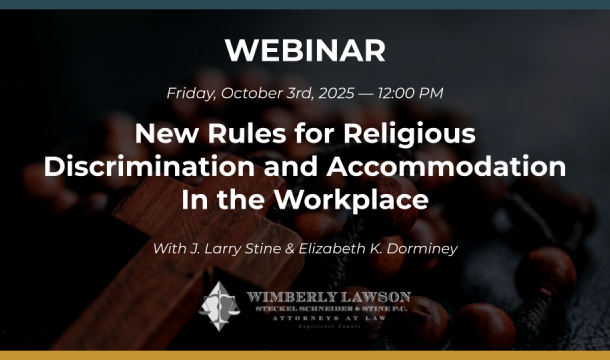When is COVID-19 Considered a “Disability” Under the ADA?
Today, the EEOC issued some new guidance that purports to clarify circumstances in which COVID-19 may or may not cause effects sufficient to meet the definition of “actual” or “record of” a disability for various purposes under Title I, as well as section 501 of the Rehabilitation Act. However, finding clarity on anything related to the ADA is a challenge, to say the least.
As an initial matter, the EEOC tells us that COVID-19 is not always considered to be a “disability.” Rather, each case must be examined on its own facts.
The ADA’s three-part definition of disability applies to COVID-19 in the same way it applies to any other medical condition. A person can be an individual with a “disability” for purposes of the ADA in one of three ways:
- “Actual” Disability: The person has a physical or mental impairment that substantially limits a major life activity (such as walking, talking, seeing, hearing, or learning, or operation of a major bodily function);
- “Record of” a Disability: The person has a history or “record of” an actual disability (such as cancer that is in remission); or
- “Regarded as” an Individual with a Disability: The person is subject to an adverse action because of an individual’s impairment or an impairment the employer believes the individual has, whether or not the impairment limits or is perceived to limit a major life activity, unless the impairment is objectively both transitory (lasting or expected to last six months or less) and minor.
The ADA uses a case-by-case approach to determine if an applicant or employee meets any one of the three above definitions of “disability.”
How does this apply to COVID-19? Depending on the specific facts involved in an individual employee’s condition, a person with COVID-19 has an actual disability if the person’s medical condition or any of its symptoms is a “physical or mental” impairment that “substantially limits one or more major life activities.” An individualized assessment is necessary to determine whether the effects of a person’s COVID-19 substantially limit a major life activity. This will always be a case-by-case determination that applies existing legal standards to the facts of a particular individual’s circumstances.
Keep in mind that a person infected with the virus causing COVID-19 who is asymptomatic or a person whose COVID-19 results in mild symptoms similar to those of the common cold or flu that resolve in a matter of weeks—with no other consequences—will not have an actual disability within the meaning of the ADA.
Examples of Individuals with an Impairment that Substantially Limits a Major Life Activity:
- An individual diagnosed with COVID-19 who experiences ongoing but intermittent multiple-day headaches, dizziness, brain fog, and difficulty remembering or concentrating, which the employee’s doctor attributes to the virus, is substantially limited in neurological and brain function, concentrating, and/or thinking, among other major life activities.
- An individual diagnosed with COVID-19 who initially receives supplemental oxygen for breathing difficulties and has shortness of breath, associated fatigue, and other virus-related effects that last, or are expected to last, for several months, is substantially limited in respiratory function, and possibly major life activities involving exertion, such as walking.
- An individual who has been diagnosed with COVID-19 experiences heart palpitations, chest pain, shortness of breath, and related effects due to the virus that last, or are expected to last, for several months. The individual is substantially limited in cardiovascular function and circulatory function, among others.
- An individual diagnosed with “long COVID,” who experiences COVID-19-related intestinal pain, vomiting, and nausea that linger for many months, even if intermittently, is substantially limited in gastrointestinal function, among other major life activities, and therefore has an actual disability under the ADA.
Examples of Individuals with an Impairment that Does Not Substantially Limit a Major Life Activity:
- An individual who is diagnosed with COVID-19 who experiences congestion, sore throat, fever, headaches, and/or gastrointestinal discomfort, which resolve within several weeks, but experiences no further symptoms or effects, is not substantially limited in a major bodily function or other major life activity, and therefore does not have an actual disability under the ADA. This is so even though this person is subject to CDC guidance for isolation during the period of infectiousness.
- An individual who is infected with the virus causing COVID-19 but is asymptomatic—that is, does not experience any symptoms or effects—is not substantially limited in a major bodily function or other major life activity, and therefore does not have an actual disability under the ADA. This is the case even though this person is still subject to CDC guidance for isolation during the period of infectiousness.
- As noted above, even if the symptoms of COVID-19 occur intermittently, they will be deemed to substantially limit a major life activity if they are substantially limiting when active, based on an individualized assessment.
To further complicate matters, in some cases, regardless of whether an individual’s initial case of COVID-19 itself constitutes an actual disability, an individual’s COVID-19 may end up causing impairments that are themselves disabilities under the ADA. For example:
- An individual who had COVID-19 develops heart inflammation. This inflammation itself may be an impairment that substantially limits a major bodily function, such as the circulatory function, or other major life activity, such as lifting.
- During the course of COVID-19, an individual suffers an acute ischemic stroke. Due to the stroke, the individual may be substantially limited in neurological and brain (or cerebrovascular) function.
- After an individual’s COVID-19 resolves, the individual develops diabetes attributed to the COVID-19. This individual should easily be found to be substantially limited in the major life activity of endocrine function.
In some cases, an individual’s COVID-19 may also worsen the individual’s pre-existing condition that was not previously substantially limiting, making that impairment now substantially limiting. For example:
- An individual initially has a heart condition that is not substantially limiting. The individual is infected with COVID-19. The COVID-19 worsens the person’s heart condition so that the condition now substantially limits the person’s circulatory function.
The situations in which an employer might “regard” an applicant or employee with COVID-19 as an individual with a disability are varied. Some examples include:
- An employer would regard an employee as having a disability if the employer fires the individual because the employee had symptoms of COVID-19, which, although minor, lasted or were expected to last more than six months. The employer could not show that the impairment was both transitory and minor.
- An employer would regard an employee as having a disability if the employer fires the individual for having COVID-19, and the COVID-19, although lasting or expected to last less than six months, caused non-minor symptoms. In these circumstances, the employer could not show that the impairment was both transitory and minor.
It is possible that an employer may not have engaged in unlawful discrimination under the ADA even if the employer took an adverse action based on an impairment. For example, an individual still needs to be qualified for the job held or desired. Additionally, in some instances, an employer may have a defense to an action taken on the basis of the impairment. For example, the ADA’s “direct threat” defense could permit an employer to require an employee with COVID-19 or its symptoms to refrain from physically entering the workplace during the CDC-recommended period of isolation, due to the significant risk of substantial harm to the health of others.
Of course, an employer risks violating the ADA if it relies on myths, fears, or stereotypes about a condition to disallow the employee’s return to work once the employee is no longer infectious and, therefore, medically able to return without posing a direct threat to others.
The Takeaway: Most people who become sick with COVID-19 are not going to have a “disability” as defined by the ADA. However, there is a small subset of people, such as the “COVID long-haulers” who may be affected by COVID-19 to such an extent that they have a disability, as defined by the ADA, and therefore, those folks are protected from unlawful discrimination. This should be determined on a case-by-case basis.

Kathleen J. Jennings is a former principal in the Atlanta office of Wimberly, Lawson, Steckel, Schneider, & Stine, P.C. She defends employers in employment matters, such as sexual harassment, discrimination, Wage and Hour, OSHA, restrictive covenants, and other employment litigation and provides training and counseling to employers in employment matters.
Related Content
Get Email Updates
Recent Content

Trump Nominates Appointments to NLRB and EEOC but Policy Changes Likely to Be Delayed

DOL Launches Self-Audit Programs Designed to Help Employers Improve Compliance

DOL Must Release EEO-1 Reports to the Public under Open Records Laws

Current Advice on Active-Shooter Situations

New Policy for Federal Workers and Religious Expressions



